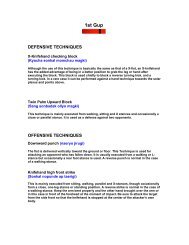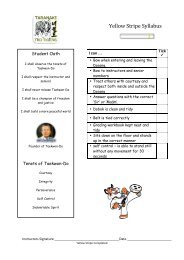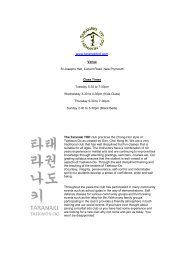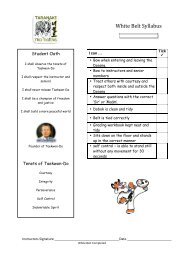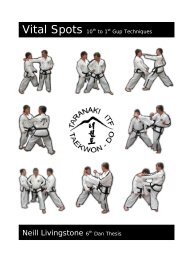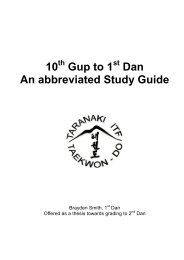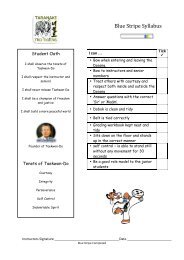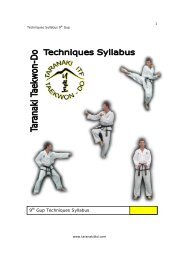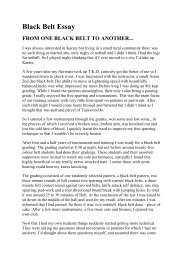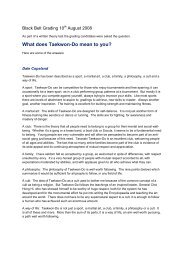2nd Gup Techniques Syllabus - Taranaki ITF Taekwondo
2nd Gup Techniques Syllabus - Taranaki ITF Taekwondo
2nd Gup Techniques Syllabus - Taranaki ITF Taekwondo
- No tags were found...
Create successful ePaper yourself
Turn your PDF publications into a flip-book with our unique Google optimized e-Paper software.
<strong>Techniques</strong> <strong>Syllabus</strong> <strong>2nd</strong> <strong>Gup</strong><br />
1<br />
<strong>2nd</strong> <strong>Gup</strong> <strong>Techniques</strong> <strong>Syllabus</strong><br />
www.taranakitkd.com
<strong>Techniques</strong> <strong>Syllabus</strong> <strong>2nd</strong> <strong>Gup</strong><br />
2<br />
STANCES<br />
Vertical stance (soojik sogi)<br />
<br />
<br />
<br />
<br />
<br />
Move one foot to either front or side at a distance of one shoulder width<br />
between the big toes.<br />
The ratio of body weight is 60 percent on the rear<br />
leg and 40 percent on the front leg.<br />
Keep the toes of both feet pointed approximately<br />
15 degrees inward.<br />
Keep the legs straight.<br />
When the right foot is in the rear, the stance is<br />
called a right vertical stance and vice-versa. It is<br />
always half facing, both in attack and defence.<br />
Close ready stance C (moa junbi sogi C)<br />
The distance between the hands and<br />
the abdomen is about 10 centimetres.<br />
Sliding (mikulgi)<br />
This is one of the most effective techniques in Taekwon-Do for covering a long<br />
distance in one smooth motion. It is mainly performed with L-stance and rear foot<br />
stances, though occasionally a sitting or fixed stance is used. It can also be executed<br />
from any combination e.g. slide shifting, shift sliding, step sliding, shift step sliding,<br />
double slide-stepping or double step-shift sliding, and so on.<br />
www.taranakitkd.com
<strong>Techniques</strong> <strong>Syllabus</strong> <strong>2nd</strong> <strong>Gup</strong><br />
3<br />
DEFENSIVE TECHNIQUES<br />
Palm pushing block (sonbadak miro magki)<br />
This technique is one of the most effective forms to put the<br />
opponent of balance. When performing a pushing block with the<br />
palm it is mainly executed from a sitting stance and X-stance,<br />
though occasionally a parallel; close or walking stance is<br />
employed. A reverse block is normal in the case of a walking<br />
stance. Be sure to execute the block against the shoulder or<br />
bottom area.<br />
Side front block (yobap magki)<br />
This technique is employed when intercepting an attack<br />
from a side front angle toward the high section of the<br />
body. It is mainly executed from close, parallel and sitting<br />
stances but occasionally one-leg and X-stances are used.<br />
The inner forearm and reverse knifehand are the blocking<br />
tools. Only an outward block is possible. Keep the middle<br />
finger formed a straight line with the shoulder bending the<br />
elbow 80 degrees while extending the opposite arm sidedownward<br />
at the moment of the block.<br />
www.taranakitkd.com
<strong>Techniques</strong> <strong>Syllabus</strong> <strong>2nd</strong> <strong>Gup</strong><br />
4<br />
Front checking kick (apcha momchugi)<br />
This technique is performed with the back sole supported<br />
by the ball of the foot. Unlike the previous kicks, the<br />
checking kick is kept momentarily on the target during the<br />
block. Since the purpose of this kick is to restrict the<br />
opponent’s freedom of movement, it is normally executed<br />
when the opponent rushes or attempts to close in. The<br />
chest and solar plexus are the targets.<br />
Basic principles:<br />
The blocking tool should reach the target in a<br />
straight line.<br />
Keep the body half facing the target at the moment<br />
of the impact.<br />
Do not bend the stationary leg more than<br />
necessary at the moment of impact.<br />
Side checking Kick (yopcha momchugi)<br />
This technique has a dual function. One is to block the<br />
attacking foot directed to a low section and the other is<br />
to impede or check the opponent’s movement. In both<br />
cases the foot must be ready for a counter-attack or<br />
any type of consecutive action. The tibia or knee area<br />
is the target, and the blocking tool should reach the<br />
target in an arc.<br />
Flying hooking Kick (twimyo golcho chagi)<br />
This technique is used in blocking the attacking hand or foot while flying. The<br />
method of the kick is the same as the hooking kick except it is executed in a flying<br />
motion.<br />
www.taranakitkd.com
<strong>Techniques</strong> <strong>Syllabus</strong> <strong>2nd</strong> <strong>Gup</strong><br />
5<br />
OFFENSIVE TECHNIQUES<br />
Upward punch (ollyo jirugi)<br />
This technique is chiefly used for attacking the face or the<br />
point of the chin at a close range. It can be performed with<br />
nearly every stance although a rear foot stance and L-stance<br />
are normally used. Keep the back fist facing the front at the<br />
moment of impact while bringing the opposite side fist in<br />
front of the shoulder.<br />
Knifehand downward strike<br />
(sonkal naeryo taerigi)<br />
This technique is divided into front and side downward<br />
strikes. The attacking tool becomes level with the<br />
shoulders at the moment of impact in the case of a side<br />
downward strike. The attacking tool reaches the target<br />
in a circular motion and can be executed from all<br />
stances, although L, rear foot, vertical and X stances are<br />
the most suitable. Keep the forearms crossed in front of<br />
the chest with both fists faced upwards, placing the<br />
striking one under the other at the start of the<br />
movement.<br />
www.taranakitkd.com
<strong>Techniques</strong> <strong>Syllabus</strong> <strong>2nd</strong> <strong>Gup</strong><br />
6<br />
Side elbow thrust (yop palkup tulgi)<br />
This technique is performed with chiefly<br />
L- and rear foot stances.<br />
Be sure to pull the opposite fist to the hip while<br />
thrusting.<br />
Four directional thrust (saju tulgi)<br />
Execute a side elbow thrust in a sliding motion as in movement 25 of Hwa-Rang Tul<br />
in a four directional movement. Left and right side.<br />
Mid - air kick (twio dolmyo chagi)<br />
The method of kicking is exactly the same as the flying side piercing or thrusting kick<br />
except that the kick is executed while spinning in the air. Since the direction in which<br />
the kick will be delivered cannot be seen until the moment the kick is performed, this<br />
technique is highly valued as a surprise attack. Spinning is executed either in 360<br />
degrees or 180 degrees. The footsword is chiefly used, though occasionally the ball<br />
of the foot.<br />
Flying kicks (twimyo chagi)<br />
Flying kicks have a number of advantages: they perfect balance, develop<br />
co-ordination, condition muscles and are invaluable for attacking the high section of<br />
the body with the foot as well as developing timing and focus. They are also effective<br />
for vaulting obstacles without exposing oneself to an attack, for leaping over a pole,<br />
club or knife attack, and for stopping an onrushing or fleeing opponent, closing<br />
distances, and driving through an encirclement of several opponents.<br />
A flying kick is performed with either one motion from the spot or several<br />
motions while running: the former is most practical at a closest distance, the latter<br />
at further distances.<br />
www.taranakitkd.com
<strong>Techniques</strong> <strong>Syllabus</strong> <strong>2nd</strong> <strong>Gup</strong><br />
7<br />
PATTERNS<br />
Hwa-Rang Tul 29 movements<br />
Hwa-Rang is named after the Hwa-Rang youth group,<br />
which originated in the Silla Dynasty in the early 7th<br />
century.<br />
The 29 movements refer to the 29th Infantry Division,<br />
where Taekwon-Do developed into maturity.<br />
The Hwa-Rang code of conduct<br />
Be loyal to your King - Be obedient to your parents - Be honourable to your friends<br />
Never retreat in battle - Make a just kill<br />
Ready Posture: Close ready stance C<br />
1. Move the left foot to B to form a sitting stance toward D while executing a middle<br />
pushing block to D with the left palm.<br />
2. Execute a middle punch to D with the right fist while maintaining a sitting stance<br />
toward D.<br />
3. Execute a middle punch to D with the left fist while maintaining a sitting stance<br />
toward D.<br />
4. Execute a twin forearm block while forming a left L-stance toward A, pivoting the<br />
left foot.<br />
5. Execute an upward punch with the left fist while pulling the right side fist in front<br />
of the left shoulder, maintaining a left L-stance toward A.<br />
6. Execute a middle punch to A with the right fist while forming a right fixed stance<br />
toward A in a sliding motion.<br />
7. Execute a downward strike with the right knifehand while forming a left vertical<br />
stance toward A, pulling the right foot.<br />
8. Move the left to A, forming a left walking stance toward A while executing a<br />
middle punch to A with the left fist.<br />
9. Move the left foot to D, forming a left walking stance toward D while executing a<br />
low block to D with the left forearm.<br />
10. Move the right foot to D, forming a right walking stance toward D while executing<br />
a middle punch to D with the right fist.<br />
11. Pull the left foot toward the right foot while bringing the left palm to the right<br />
forefist at the same time bending the right elbow about 45 degrees outward.<br />
12. Execute a middle side piercing kick to D with the right foot while pulling both<br />
hands in the opposite direction, and then lower it to D, forming a left L-stance<br />
toward D, at the same time executing a middle outward strike to D with the right<br />
knifehand.<br />
13. Move the left foot to D, forming a left walking stance toward D while executing a<br />
middle punch to D with the left fist.<br />
14. Move the right foot to D, forming a right walking stance toward D, at the same<br />
time executing a middle punch to D with the right fist.<br />
www.taranakitkd.com
<strong>Techniques</strong> <strong>Syllabus</strong> <strong>2nd</strong> <strong>Gup</strong><br />
8<br />
15. Move the left foot to E, turning counter-clockwise to form a right L-stance toward<br />
E while executing a middle-guarding block to E with a knifehand.<br />
16. Move the right foot to E, forming a right walking stance toward E while executing<br />
a middle thrust to E with the right straight fingertip.<br />
17. Move the right foot on line EF, forming a right L-stance toward F while executing<br />
a middle guarding block to F with a knifehand.<br />
18. Execute a high turning kick to DF with the right foot and then lower it to F.<br />
19. Execute a high turning kick to CF with the left foot and then lower it to F, forming<br />
a right L-stance toward F while executing a middle guarding block to F with a<br />
knifehand Perform 18 & 19 in a fast motion.<br />
20. Move the left foot to C, forming a left walking stance toward C while executing a<br />
low block to C with the left forearm.<br />
21. Execute a middle punch to C with the right fist while forming a right L-stance<br />
toward C, pulling the left foot<br />
22. Move the right foot to C, forming a left L-stance toward C while executing a<br />
middle punch to C with the left fist.<br />
23. Move the left foot to C, forming a right L-stance toward C, at the same time<br />
executing a middle punch to C with the right fist.<br />
24. Execute a pressing block with an X-fist while forming a left walking stance toward<br />
C, slipping the left foot to C.<br />
25. Move the right foot to C in a sliding motion, forming a right L-stance toward D<br />
while thrusting to C with the right side elbow.<br />
26. Bring the left foot to the right foot, turning counter-clockwise to form a close<br />
stance toward B while executing a side front block with the right inner forearm<br />
while extending the left forearm to the side downward.<br />
27. Execute a front side block with the left inner forearm, extending the right<br />
forearm to the side downward while maintaining a close stance toward B.<br />
28. Move the left foot to B, forming a right L-stance toward B, at the same time<br />
executing a middle guarding block to B with a knifehand.<br />
29. Bring the left foot to the right foot and then move the right foot to A, forming a<br />
left L-stance toward A while executing a middle guarding block to A with a<br />
knifehand.<br />
End: Bring the right foot back to ready posture.<br />
SPARRING<br />
One step sparring (ilbo matsogi)<br />
Flying Kicks<br />
Compulsory techniques: Flying Back Kick, Flying Reverse Turning Kick,<br />
Flying Twisting Kick, Flying Reverse Hooking Kick, Flying Downward Kick.<br />
www.taranakitkd.com
<strong>Techniques</strong> <strong>Syllabus</strong> <strong>2nd</strong> <strong>Gup</strong><br />
9<br />
Free sparring (jayu matsogi)<br />
With sparring equipment and without sparring equipment<br />
SELF DEFENCE (hosin sul)<br />
Showing attacking, breaking and releasing techniques<br />
Release per Hwa-Rang, movement 11<br />
Defence against the following attacks must contain<br />
knees and elbows as counter attacks<br />
Defence against -<br />
Twin Palm push<br />
Straight punch<br />
Back fist strike<br />
Hook punch<br />
Double hook punch<br />
Grab & hook punch<br />
Break falls – Side, front & back<br />
Rolling Break falls - Front & back<br />
DESTRUCTION<br />
Flying Kicks - Front Kick, Side Kick, Turning Kick, Back Kick<br />
Hand technique - Knifehand side strike, Reverse knifehand strike<br />
www.taranakitkd.com
<strong>Techniques</strong> <strong>Syllabus</strong> <strong>2nd</strong> <strong>Gup</strong><br />
10<br />
THEORY<br />
All Taekwon-Do terminology above<br />
Procedure for leading the class<br />
Face the flag - kukki e tae hae<br />
Face Instructor - (1st to 3rd Dan) - boosabum nim kke<br />
Face Instructor - (4th to 6th Dan) - sabum nim kke<br />
Face Master - (7th & 8th Dan) - sahyun nim kke<br />
Face Grand Master - (9th Dan) - saseong nim kke<br />
Ready - junbi Start - si jak Stop - guman At ease - swiyo Repeat - tashi<br />
Return - baro Yell - kihap About turn - twio tora Class dismissed - hae san<br />
Meaning of the red belt<br />
Red signifies danger, cautioning the student to exercise control and warning the<br />
opponent to stay away.<br />
History of Taekwon-Do<br />
Taekwon-Do was named on 11th April 1955. This is not to say that Korean martial<br />
arts did not exist before then, but that was the year in which the name was first put<br />
forward. The origins of Taekwon-Do can be traced to Tae Kyon, the art of self<br />
defence which originated 1300 years ago during the Silla Dynasty in Korea. Tae Kyon<br />
was taught and practised among the youths of 'Hwarang-Do', who were hand picked<br />
to be trained as military leaders of Silla, one of the three ruling kingdoms of Korea at<br />
that time. Tae Kyon's effectiveness was enhanced at the turn of the 20 th century,<br />
when hand techniques were introduced from China and later from Japan.<br />
Japan occupied Korea for many years and during the Second World War the two<br />
countries were co-belligerents. Many Koreans fought on the side of the Japanese and<br />
received training in the Japanese martial arts systems.<br />
One of the most prominent personalities at this time was General Choi Hong Hi.<br />
www.taranakitkd.com
<strong>Techniques</strong> <strong>Syllabus</strong> <strong>2nd</strong> <strong>Gup</strong><br />
11<br />
Gen. Choi had studied the Korean art of tae Kyon as a child and as a student in<br />
Japan he had learned Karate. This combination of Korean and Japanese knowledge<br />
was to form the basis of his teachings at the academy of martial arts formed in<br />
1953. Being a professional soldier, he was able to introduce the teaching of his<br />
system to the men under his command. Through his military liaison with foreign<br />
units, Gen. Choi spread the knowledge of his system until it became international.<br />
Gen. Choi organised the first international demonstration tour, the consequences of<br />
which contributed towards the eventual formation of the International Taekwon-Do<br />
Federation on 22 March 1966. In 1972, as a result of political pressure within South<br />
Korea, Gen. Choi left the country to re-establish the headquarters of the <strong>ITF</strong> in<br />
Canada, later to be relocated to Vienna. The Korean government quickly set up a<br />
rival international body, calling it the World Taekwon-Do Federation. Since that time,<br />
Taekwon-Do has been divided, and the techniques, patterns and systems differ<br />
between the two styles. <strong>ITF</strong>NZ continue to practice the original form of Taekwon-Do,<br />
The Chang-Hon style.<br />
The theories, terminology, techniques, systems, methods, rules, uniform, and<br />
philosophical foundation were scientifically developed, systemized and named by<br />
Gen. Choi Hong Hi. Hence it is an error to think of any other actions employing the<br />
feet or hands for self-defence as Taekwon-Do. On a philosophical level, Taekwon-Do<br />
is derived from the traditional, ethical and moral principals of the Orient and from<br />
the personal philosophy of Gen. Choi.<br />
The Physical techniques of Taekwon-Do are based on the principals of modern<br />
science, in particular Newtonian physics which teaches us how to generate maximum<br />
power. Although Karate and Tae Kyon were used as references in the course of<br />
developing the art, the fundamental theories and principles of Taekwon-Do are<br />
different from those of any other martial art.<br />
Credit Points – 9 points needed<br />
www.taranakitkd.com



